
Website founded by
Milan Velimirović
in 2006
23:58 UTC


| |
MatPlus.Net  Forum Forum  Competitions Competitions  Chess Problems & Studies Discord Composition Tournament #0 Chess Problems & Studies Discord Composition Tournament #0 |
| |
|
|
|
|
You can only view this page!
| | Page: [Previous] [Next] 1 2 | | (1) Posted by edderiofer [Wednesday, Mar 31, 2021 17:20] | Chess Problems & Studies Discord Composition Tournament #0
APRIL FOOL'S, EVERYONE!
Inspired by the day of practical jokers, I've decided to host an informal composition tournament on the Chess Problems & Studies Discord (http://discord.me/chessproblems). Your task is to compose any joke problem! (THIS IS AN INFORMAL TOURNAMENT FOR WHICH THERE IS NO PRIZE.)
1. This tournament is organized and judged by edderiofer.
2. All puzzles will be pitted against each other in a single division and will primarily be judged on humour. (Hey, this is an informal April Fools tournament.)
3. The following conditions apply:
* Entries should consist of the board position, stipulation, and the intended solution. (Also be prepared to explain the joke if I don't get it.)
* The problem must be original and composed by the submitter. Anticipated problems may be disqualified at the organiser's discretion.
* The problem must be sound, in that the intended solution(s) should be the only one(s).
4. There is no maximum on the number of entries per author. Submit as many as you want.
5. Please send all entries via Discord DMs to @edderiofer#0713, or via email to [username]@gmail.com.
6. The submission phase will run until 2021-04-02, 15:00 UTC. After this, there will be a small delay for the purposes of verification, amendments, and judging.
7. All eligible submissions will receive a ranking (even if there are very few submissions). Honourable Mentions may be given to disqualified or late entries. All other disqualified/late entries that are not given an Honourable Mention will not be published.
| | | (2) Posted by edderiofer [Sunday, Apr 4, 2021 17:41] |
(The Discord server contains allowances for spoiler bars, while MatPlus doesn't. It is recommended that you read this post there, as solutions and comments will be in spoilers there to give people a chance to solve the problems.)
The tournament submission period has now ended, and the ranking of the entries is now ready to be revealed! But first, some thoughts:
The primary purpose of this tournament was because I think April Fool's Day should be a day of celebrating pranks and jokes, not necessarily of pulling those pranks and jokes on other people (which can of course ruin friendships). In another community I'm in, we make joke puzzles as an informal thing for April Fool's Day, and I thought "What better way to encourage people to make joke chess problems for April Fool's Day than to run a tournament asking people to make joke chess problems?". I also hoped that this would encourage people who had little or no experience constructing problems to get into the hobby more.
I originally feared that, given the short time limit, I'd get maybe 3 or 4 entries tops, and only from the experienced problemists. Well, we had 11 entries on the first day alone, followed by 8 entries the next, for a total of 19 entries (one was completely disqualified), of which 12 were submitted by relative beginner problemists, so I'm very glad my fears were for naught. While it's true that the experienced problemists tended to rank higher, it doesn't seem to have shut out the newcomers at all.
The secondary purpose of this tournament, which I've said in #general, was to gauge interest in problems before CP&SDS Construction Tournament #1 (which, given the interest in this tournament, will almost certainly be happening in a month or two), and to let me learn any pitfalls and mistakes before the first "official" tournament. That's also the main reason this is Tournament #0 and not Tournament #1. (To avoid any potential bias, as pointed out by Rewan, Tournament #1 will likely be voted on by the server and not judged by any single person; more details to follow on that front. Thankfully this tournament was very informal with no prize and for joke chess problems, so hopefully bias wasn't much of a worry.)
Some of these problems really toed the line of being a chess problem. By nature, many joke chess problems simply can't work as regular problems; only five of the submissions here can, and the rest have their humour in part from how they bend/break the rules of chess and chess problems. This made deciding what to disqualify a little difficult at times. In the end, only one problem was fully disqualified, because the solution given didn't actually accomplish its stipulation and it wasn't particularly funny either.
Likewise, ranking some of these entries (by how funny they were to me) was also difficult. Most of these did at least elicit a smile from me, but of course I can't put all of them near the top! If your problem didn't do as well as you'd hoped, don't lose heart; there will (hopefully) be plenty more composition tournaments on the server.
I'm VERY thankful nobody decided to abuse the lack of an entry limit to submit the same problem an inordinate number of times. (Don't do this next year, either.)
Based on the popularity, I think this joke tournament should become a yearly thing for April Fool's Day (though a couple of things will likely have to change about it, like the numbering scheme and the judging process). It seems to have been quite good at encouraging people to construct problems.
---
First, let's start with the one HM:
jkittykitkat: "White to play and win"
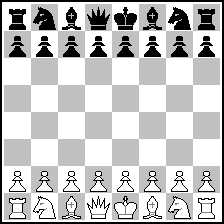 (= 16+16 ) (= 16+16 )
No solution was provided and I can't exactly say this is original, as much as I did find it funny that someone would submit this. Besides, this problem is cooked anyway; it's well known that the starting position in chess is actually a zugzwang, so White has no way to win here. :P
---
Now, I received 17 other submissions that placed. Starting from the bottom of the list:
In 17th place, LilHamood: "Complete the suspicious gambit"  (= 20+6 ) (= 20+6 )
Solution: 1...e6!
haha among us funny (For those of us who aren't so familiar with internet meme culture, https://knowyourmeme.com/memes/things-that-look-like-among-us-crewmates)
In 16th place, Silverbyte: "White to play and liberate Japan in 25 eps."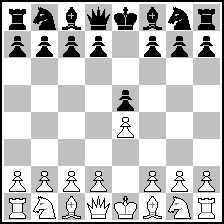 (= 16+16 ) (= 16+16 )
Solution: 1.Ke2!
This is apparently a reference to one of the many chess games played in the anime Code Geass, which I've watched almost none of, so perhaps the joke is lost on me. The stipulation is definitely outlandish, though, but if you're going to reference Code Geass' chess scenes, you probably would have placed higher had you used the stipulation "White to play and cover the screen in subtitles" with the appropriate position...
In 15th place, Ethan Donaghue: "White to move and win"
 (= 14+10 ) (= 14+10 )
Solution: 1.Qa8#!
The joke is apparently that you have to give up on the legendary 7-queen fork. I feel like you could easily stuff more queens under attack via the use of discovered attacks. (The position is illegal, but that's not a problem since this is a joke composition tournament.)
In 14th place, Silverbyte: "Mate in 2."
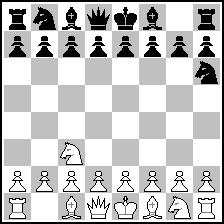 (= 16+16 ) (= 16+16 )
Solution: 1.Nd5! Nc4/Nb5 2.Nc3#/Ne3#" (board is presented upside-down)
I've seen enough upside-down board compositions to last me for a good while. However, unlike most upside-down board compositions, the upside-down position is illegal; the only thing here that tells you that the board is upside-down are the coordinates given in the original image sent to me. (If you're reading this writeup on MatPlus, which doesn't show coordinates and doesn't allow me to embed an image with coordinates, this joke problem doesn't really work. Sorry.)
In 13th place, Finneon 7: "White to mate Black in 8, with the final mate given by an en passant capture."
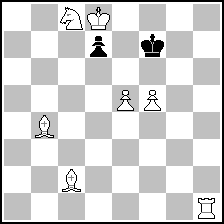 (= 7+2 ) (= 7+2 )
Solution: 1.Nd6+ Kf8 2.Be1 Kg8 3.Bh4 Kg7 4.Be7 Kg8 5.Bb1(any other waiting move also works) Kg7 6.Ne8+ Kf7 7.Ba2+ d5 8.exd6#
Not entirely sure if this is a joke composition per se, and I am judging these on humour after all. Save for the dual waiting move, this is a cool problem with a novel stipulation that probably would have placed higher had the tournament's theme been "novel stipulations".
In 12th place, LilHamood: "Make a legal move"
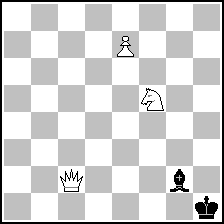 (= 3+2 ) (= 3+2 )
Solution: 1.e8=K!
The joke being of course that that's the only move you can make to make the position legal (yes i know it doesnt really work and yes i know i shouldnt be lumping illegal-position problems with legal-position problems but this is an informal april fools tournament so whatever).
In 11th place, Finneon 7: "White to move, find the fastest helpstalemate"
 (= 3+8 ) (= 3+8 )
Solution: 1.Kxd3 Qf2= (we didn't explicitly specify who should be stalemated)
To my understanding, at least, helpstalemates generally end in Black being stalemated, not White. I suspect that the joke of this problem would trip up more experienced problemists more than the novices in this server.
In 10th place, Siegfried Hornecker: "Seriesmover. Exchange the position of two pieces as quickly as possible. What is the first and what is the last move?"
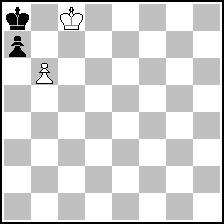 (= 2+2 ) (= 2+2 )
Solution: First move 1...axb6, last move 9...Qa8+. The try 9.Ba8 fails to a dead position after bishop promotion.
The joke here is subtle; the Dead Reckoning rule isn't usually invoked in forward-play problems, but it is here! Unfortunately it's also the sort of joke which requires one to be more familiar with the Codex than I apparently was. The retro-analysis shows that it's Black to move here and not White (not that it's possible to solve the problem with White to move anyway).
In 9th place, Per Olin: "31 undetermined pieces. Black is making his 3rd move aand White mates in his 4th. Chess960 initial game array and game?"
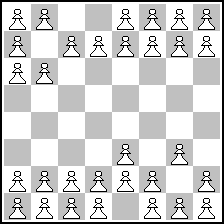 (= 31+0 ) (= 31+0 )
Solution (and explanation of joke): https://drive.google.com/file/d/1KwQJ2AnOkXAFKWTgu0FeIkqNHOkegocV/view?usp=sharing
Unfortunately, this rather complex problem was received about 6 hours before the end of the submission period, on a day when I was already extremely tired, so I'm sorry I couldn't wrestle with this problem beforehand to appreciate the joke properly for myself.
In 8th place, Silverbyte: "Mate in 3"
 (= 9+7 ) (= 9+7 )
Solution: 1.Qf4 Nxf4 2.exf4 Kf6 3.Bd4#
Look at the position of pieces in the final mate! If that's not a problem that makes one laugh, I don't know what is. XD
In 7th place, James Malcom: "White to play and draw, Dedicated To Peter Wong".
 (= 5+13 ) (= 5+13 )
Solution: 1. g8=P! Rxg8+ 2. fxg8=P Rxg8+ 3. hxg8=P Bd6 4. b8=P=
Ah, dummy pawn "promotion". I believe it was James who first posted a dummy-pawn problem to the server. I don't really have much else to say here, though.
In 6th place, Ethan Donaghue: "Black to play and win."
 (= 8+3 ) (= 8+3 )
Solution: 1.d5 exd6 e.p. {the opponent has to do this because it's such a cool move} 2.Re1#
It should be noted that this submission was received before Tangentg posted the "Hardest Decision in Chess, Checkmate or En Passant?" video in #general, so at the time of receipt, it was definitely original and funny. And yes, I know this problem isn't technically sound because White has better, but again, it's still funny.
In 5th place, Dmitri Turevski: "Masand, c7:Eagle, h#2.5"
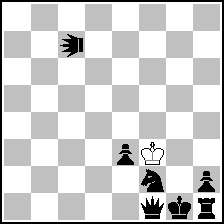 (= 1+7 ) (= 1+7 )
Masand: A piece which directly threatens the opposite King, after it moves, changes the color of the pieces it controls or attacks, except the Kings. Castling may be done with a colour-changed rook in the corner.
Eagle: Moves like a Grasshopper, but deflects 90° either way on passing over the hurdle. The arrival square is adjacent to the hurdle.
Solution:1...Kf4 2.Qc4[c7=w]+ Kg3 3.Qf1 Kf3#
The subtle joke here is that the end position is otherwise the same as the start position except with White to move and with the Eagle having changed colours, so this problem is "flipping the bird". Puns may be considered by some to be the lowest form of humour, but I thought this one was good.
In 4th place, Per Olin: "Chess960. Add the Black king to give the shortest possible helpmate."
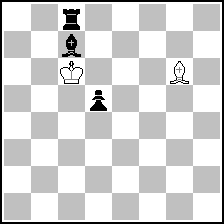 (= 2+3 ) (= 2+3 )
Solution (and explanation of joke): https://drive.google.com/file/d/19ukT2hY8zDGeVYlihgBYbMopo86GoGwg/view?usp=sharing
This is a reprise of the joke from 9th place, but in a much simpler setting. This one arrived ten minutes before the submission period closed, again on the same day when I was already extremely tired, so thankfully I was able to appreciate this one better! Adding a piece outside the board is pretty cool.
In 3rd place, Adrian Storisteanu: ""Better late than never", h#1 (-:"
 (= 4+3 ) (= 4+3 )
Solution: 1.d5 Be4 2.Bd7 exd6e.p.#
As the title of the problem says, better late than never! Black and White have to each play a move in between 1.d5 and exd6e.p.! Luckily, Black is very accommodating, as in the spirit of a helpmate. Yep, that's totally a helpmate in one. :P
In 2nd place, Adrian Storisteanu: "switcheroo # ≤1* (-: (swap two pieces for mate in one or less)"
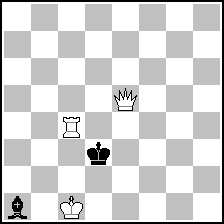 (= 3+2 ) (= 3+2 )
Set mate: 1.Qe5-e4#. Solution: Swap Rc4<->Ba1 and now Ra1->d1, completing 0-0-0#
Another mid-castling position. "≤1" here initially suggested to me "in 0 or 1 plies", but of course, 0.5 ≤ 1 too. (Should that be 0.25 if it's in a helpmate? I don't know.)
And finally, in 1st place, Tiralmo: "White to mate in 3"
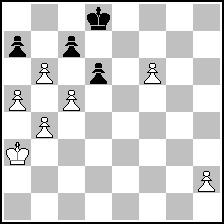 (= 7+4 ) (= 7+4 )
Solution: e5xd6+ axb6+; bxc5xc7=K Kc7+; Kb8xc7++
Took me a moment before I realized what's happening in this problem, but once I saw that all the pieces were on dark squares, it hit me: this is a game of checkers, not a game of chess! The reveal here is brilliant.
---
Hopefully you enjoyed those joke problems, and, if you entered, composing them! I of course invite feedback/discussion about this event itself; feel free to give it in the #composition-tournaments channel on Discord or in the MatPlus thread.
| | | (3) Posted by Sarah Hornecker [Monday, Apr 5, 2021 07:01] |
Correction for my 10th place: "Quickly exchange the position of two pieces" instead of "Exchange the position of two pieces" (prevents duals that take longer)
| | | (4) Posted by Per Olin [Monday, Apr 5, 2021 10:24] |
Many thanks for this fresh initiative and for a welcome promise that this will be repeated! A thought: More than in normal composing, when composing joke problems the circumstances / surroundings are important. Have not experienced favorable conditions, so I only describe mine: not so young anymore all your bones are aching, you wake up with a dry throat, your bathroom mirror is dishonest, after this start your day turns normal i.e. worse, you cheer up only once a week shouting Mbappé Show, Rowan Atkinson in the role of a religious leader makes you yawn etc. etc. In these severe circumstances composing joke problems can be challenging; it is a much bigger effort to produce something funny. Can this somehow be taken into account when judging?
| | | (5) Posted by Hauke Reddmann [Monday, Apr 5, 2021 19:03] |
Dear Per, I get screwed over by life almost on a daily basis, but never lost my caustic sense of humor, which is the only thing that stands between me and 10 m downwards from my skycraper window. (Also, want to see the Riemann hypothesis proven.) Still laughing about Dimitri's howler. Which I would have placed #1, proving that humors are naturally different. For the same reason (and after all, composers abilities are different on other areas either), your proposal must be a joke.
Wait. Your proposal IS a joke. :-)))
| | | (6) Posted by Per Olin [Tuesday, Apr 6, 2021 11:48] |
Dear Hauke, well, yes, it was a joke in the spirit of April Fool's Day. It is understandable that it is confusing that somebody tells a joke on a Monday. Anyhow, you scored a full point; what are you going to do with the point?
--------------------------------------------
Once in the area of chess jokes, a tribute to Bedrich Formánek and his book CHESS JOKES. Bedrich Formánek was a long-time delegate for Czechoslovakia and later for Slovakia in Permanent Commission of the FIDE for Chess Compositions (PCCC), serving in years 1994-2002 as PCCC President, becoming an honorary president of the current WFCC afterwards. His book contains 50 joke compositions with comments of the same high and humorous level as the compositions; in other words, a book highly recommended. An example with comments by the author:
Bedrich Formánek
SV CSZTV (Closing date 31.10.1966)
3rd Prize
 (= 8+2 ) (= 8+2 )
Mate in 1 move
The black king can only have come to h5 from g6, having escaped from a discovered check. But what piece gave this check? If we consider the better-known fairy pieces, there are only two possibilities: a grasshopper playing Gf5-h5+ or a camel playing Ce4-h5+. The problem is therefore solved by 1.gxh8G# in the first case and 1.g8C# in the second, these promotions being allowed because the relevant pieces have already been on the board.
Grasshopper - moves along queen-lines, but must hop over another unit of either color and land on the next square beyond
Camel - moves by hopping to the second nearest square of the same color on the neighboring file or rank (e.g. Ca1-b4, Ca1-d2)
----------------------------------------
Further from the book:
- Formánek also gives a definition of a chess joke: 'Joke composition = A chess composition with a witty solution depending on a change to the rules of the game, this change not being mentioned in the stipulation.'
- Mentioned is also a Codex of Joke Composition; this is to be found nowhere, perhaps it is something flexible, which serves best not published!?
| | | (7) Posted by edderiofer [Tuesday, Apr 6, 2021 17:24] |
Ha, that's a clever composition. I'm not sure what tournament it was entered in that it won 3rd prize, but if it was also a joke composition tournament, I'd love to see the results for that.
Googling, I did find this one problem by Bedrich that I found amusing, if only for the diagram:
Formanek, Bedrich
Schach-Echo, 1972
All non-king pieces are grasshoppers. h#2, 2 sols.
 (= 8+56 ) (= 8+56 )
Methinks he has a good sense of humour.
It's a shame that I can't find very much information on his book, though, including whether it's in English or in Slovak (my guess is on the latter). I'd love to read through that book or a translation of it, but it looks like it's out-of-print and expensive second-hand. Guess that's the reality of any niche hobby like chess problems.
| | | (8) Posted by Per Olin [Tuesday, Apr 6, 2021 23:48] |
Half a point scored for the guess that the book is in Slovak; it is in both Slovak and English. More details:
Šachové žarty - Chess Jokes (2000) © Bedrich Formánek
Author: Bedrich Formánek
Editor: Bedrich Formánek
Computer realization: Ivan Jarolin
Published by Národné osvetové centrum, Bratislava
Printed by Národné osvetové centrum, Bratislava
-----------------------
As it is possible to have also fairy pieces here, below a problem that I had as an alternative to the one in post 6. A couple of decades ago there was a competition for the best problems published during the past century. It was for different problem types: best twomover, best threemover, best study etc. It must have been arranged by serious people, because there was no section for joke problems. Here a problem that, in my opinion, would land very high in a ranking covering all published joke problems.
Bedrich Formánek
Memorial Breyer (Closing date 31.12.1973)
1st Prize
 (= 3+4 ) (= 3+4 )
Mate in 2 moves
Grasshoppers Ga8, Ga7
Solution and comments by the author: 1.Ga8Q! (turning the grasshopper symbol 180 degrees) Zugzwang 1. - Gg1 2.Qa8G#, 1. - Ga7Q 2.Qh1#, 1. - f5 Qh8# - The turning of a unit on its own has not provoked any objection. This problem even gave so much pleasure that it found its way into the FIDE Album (1971-1973); so far, the only joke composition to have done so.
| | | (9) Posted by Andrew Buchanan [Thursday, Apr 29, 2021 10:37] |
Yet another #1 that has occurred to me too late for the #1 competition! :-)
After Bedrich Formánek
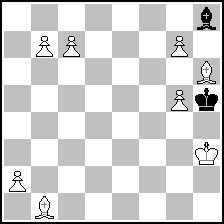 (= 8+2 ) (= 8+2 )
#1 (-: 4 solutions
I guess the full "decimal notation" for those that like that kind of stipulation format would be just: 4
Same units as Formánek's original, but rearranged to give double the mates :-)
| | | (10) Posted by Torsten Linß [Thursday, Apr 29, 2021 11:03] |
Bedrich's problem has a nice try: white Eagle (=EA) moving over Kg6 to h5 allows 1.g8=EA, but fails to 1... Bg7!
| | | (11) Posted by Andrew Buchanan [Thursday, Apr 29, 2021 11:54] |
Hi Torsten,
I aim of course for:
R: 1. Kg6xNh5 Nd3-h5+ allowing F: 1. b8=N# (N = Nightrider)
R: 1. Kg67xGZh5 GZc2-h5+ allowing F: 1. c8=GZ# (GZ = Gazelle = 3,5-Springer)
If there are any other tries or cooks apart from the thwarted Eagle you spotted, I would be interested to know. Can one run WinChloe or Popeye with promotion to *any* fairy units possible? :-)
| | | (12) Posted by Torsten Linß [Thursday, Apr 29, 2021 16:02] |
Actually, Lion instead of Grashopper "cooks" both versions.
| | | (13) Posted by Andrew Buchanan [Thursday, Apr 29, 2021 17:50] |
QUOTE
Actually, Lion instead of Grashopper "cooks" both versions.
Well spotted too. Lion strictly dominates Grasshopper in terms of movement. There's no way we could fix that, except by changing the diagram so that *only* Lion, but not Grasshopper, can work. But then some charm would be lost, because Grasshopper is a more iconic fairy piece.
In order to restore "soundness" to what is after all only a joke (-: I appeal to Occam's Razor! We'll presume the simplest, most common unit that works, and we'll deem that we're not cooked by any other strictly dominant piece.
Other obvious examples of domination are Gnu dominating Camel, Gnurider dominating Nightrider, Camelrider dominating Camel, Camelrose dominating Camel etc. Occam's Razor cleanly cuts through all of these concerns.
| | | (14) Posted by seetharaman kalyan [Friday, Apr 30, 2021 00:26] |
Add two pawns c4 & c6. Fifth mate
1.c8DG#. (double G)
| | | (15) Posted by Andrew Buchanan [Friday, Apr 30, 2021 03:33] |
Cool idea, Seetheraman. Wherever DG starts is on the diagonal c2-f5, it can move to h5 via h7, if I've understood it properly. So we don't need to add c4. But c6 or e6 is enough to allow for c8=DG to work. I am not sure how I feel about adding a 5th solution, since it kind of breaks the symmetry. Maybe could add bBa1 & wPa6, so at least we have a new mating square. The fact that there are 5 promotion squares possible but only 4 squares on the diagonal would hint that the 5th solution must be somehow more general. bBa1 & wPa6 which are not used in any other solution do give a broad hint.
How iconic is a DG? It seems a bit obscure to me. The other solutions were the famous G, N & two x,y-Leapers. Everyone knows them. I am not familiar with the whimsical world of fairy pieces: maybe someone can advise. Either this DG is reasonably well known, and we can have it as the "fifth element", the icing on the cake, or we decide it's too obscure, and add DG to the set of official tries. Please tell me what you think, Seetheraman.
Really we should engage Bedrich Formánek on this. I sent him a Note here. He last logged into MatPlus in Feb, so if anyone has an email address for him, please tell him.
Any other fairy pieces do anything interesting here?
| | | (16) Posted by seetharaman kalyan [Friday, Apr 30, 2021 20:05] |
You are right. I forgot that bK starts on g6, so no need for c4.
DG however is less iconic than Grasshopper, Nightrider or camel. But other leaper Gazelle is lesser known like DG.
| | | (17) Posted by Andrew Buchanan [Saturday, May 1, 2021 03:58] |
Gazelle and most specific members of the zoo of x,y-leapers are obscure, but I meant that the fact there *are* arbitrary leapers for any x & y is well-known. If DG arrives on a8, we would still have 4-fold symmetry (because DG might have started anywhere on the diagonal), and as mentioned there are enough clues to find the "5th element", so I'm in favour of adding DG as icing on the cake.
Waiting also for the author, and to see if there are any other cool fairy piece discoveries :-)
| | | (18) Posted by Andrew Buchanan [Sunday, Jun 20, 2021 10:09] |
There's nothing as grating as a joke pushed too far, and that's certainly what I've tried to do with https://pdb.dieschwalbe.de/search.jsp#P1390927:
A.Buchanan after B.Formanek
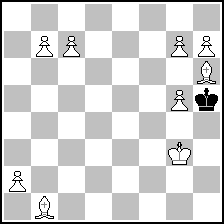 (= 9+1 ) (= 9+1 )
#1 (:
6+ parts
To be fair, many good fairy ideas originated as jokes. Bedrich is happy with his own problem, but welcomes me to make a larger zoo "after". I think this problem is trying to be a kind of PRA. For any recently-departed fairy piece which explains the history, there should be a unique phoenix promotion which is #1. Hence pieces like Camelrider & Gnu do not cook the problem, they would merely add parts (although it would be tedious to include them in the solution - a representative of each pattern will do). On the other hand, Eagle, which Torsten presented as a try, *does* break stuff, because it's a distinct history admitting no #1. Fixing that bug made the Double Grasshopper possibility go away - I'm happy to add a little more machinery for the #1, but I think the retro play should generally emerge from the current material in the diagram, rather than via adding extra pieces artificially. wK is shifted to g3 from h3 in order to retro-block (2x0)-Zigzag Nightrider, which can't #1 in forward play.
The current count is *6* creatures in the zoo. Please can you find other fairy pieces which might just have been captured on h5? Either with or without forward #1 in the current position. Thanks so much!
The only other thing to say is that Bedrich's chess joke book is terrific. The chess and jokes are both excellent, and John Beasley's excellent translation is perfect for this kind of material.
| | | (19) Posted by Joost de Heer [Sunday, Jun 20, 2021 21:48] |
Quick loop over all pieces in Popeye:
1...35c2*h5 + 2.Kg6*h5 c7-c8=35 #
1...AOd3*h5 + 2.Kg6*h5 b7-b8=AO #
1...BIe4*h5 + 2.Kg6*h5 g7-g8=BI #
1...CAe4*h5 + 2.Kg6*h5 g7-g8=CA #
1...CRe4*h5 + 2.Kg6*h5 g7-g8=CR #
1...DOf5*h5 + 2.Kg6*h5 h7-h8=DO #
1...EAc2*h5 + 2.Kg6*h5 g7-g8=EA #
1...EAd3*h5 + 2.Kg6*h5 g7-g8=EA #
1...EAe4*h5 + 2.Kg6*h5 g7-g8=EA #
1...Gf5*h5 + 2.Kg6*h5 h7-h8=G #
1...GLf5*h5 + 2.Kg6*h5 h7-h8=GL #
1...GNe4*h5 + 2.Kg6*h5 g7-g8=GN #
1...GRd3*h5 + 2.Kg6*h5 b7-b8=GR #
1...GRd3*h5 + 2.Kg6*h5 g7-g8=GR #
1...GRe4*h5 + 2.Kg6*h5 b7-b8=GR #
1...GRe4*h5 + 2.Kg6*h5 g7-g8=GR #
1...LEf5*h5 + 2.Kg6*h5 h7-h8=LE #
1...LIf5*h5 + 2.Kg6*h5 h7-h8=LI #
1...MGc2*h5 + 2.Kg6*h5 g7-g8=MG #
1...MGc2*h5 + 2.Kg6*h5 h7-h8=MG #
1...MGd3*h5 + 2.Kg6*h5 g7-g8=MG #
1...MGd3*h5 + 2.Kg6*h5 h7-h8=MG #
1...MGe4*h5 + 2.Kg6*h5 g7-g8=MG #
1...MGe4*h5 + 2.Kg6*h5 h7-h8=MG #
1...Nd3*h5 + 2.Kg6*h5 b7-b8=N #
1...PAf5*h5 + 2.Kg6*h5 h7-h8=PA #
1...QNe4*h5 + 2.Kg6*h5 g7-g8=QN #
1...RHf5*h5 + 2.Kg6*h5 h7-h8=RH #
1...RLf5*h5 + 2.Kg6*h5 h7-h8=RL #
1...WAd3*h5 + 2.Kg6*h5 b7-b8=WA #
1...ZEe4*h5 + 2.Kg6*h5 g7-g8=ZE #
| | | (20) Posted by Andrew Buchanan [Monday, Jun 21, 2021 03:41] |
Great work Joost! :)
(0) I've been through your detailed results, and amazingly it confirms what we had found by hand. All the new creatures are supersets of ones that we already have, and by PRA, they don't break the composition.
(1) I didn't think Popeye could retract, so how did you do this, Joost? Or did you set up all possible start positions and then run forwards? With what stipulation, please?
(2) Can you find a complete list of Popeye creatures which can explain the retroplay, but have no forward phoenix #1? Marken Foo found Dabbaba aka (0,2)-Leaper. There's also Lancer aka (2,4)-Leaper and (0,2)-Zigzag Ibisrider (Ibis aka (1,5)-Leaper). These *would* be cooks under PRA, but hehe I have invented a joke version of the meta-convention called PPRA (Partial PRA) which "applies only when it applies", allowing us to freely exclude all inconvenient cases which don't work out :) The orthodox alternative is to fail over to RS, but I don't think that is practical here. As long as we end up with more actual parts than unsolvables and major duals, then I consider this a success. So far: parts=7, unsolvables=3, major duals=0. 7>3+0 so winning so far :)
(3) Creatures featured should actually be used in some published or self-published problem. Anything in Popeye would count, but there's more. For example, "GQ" Giraffe-Quintessence is 1. c8=GQ# R: 1. GQc2-d6-h5+ Kg6xh5 appears in Winchloe 252973 Norman M. Gribbins "The Fairy Chess Review (before 1946)". It's described "Girafe Zigzag", but the solution makes clear that it's moving as Giraffe Quintessence [FYI: PDB definition "Quintessence = a rider that makes a sequence of knight moves, changing direction in a 90 degrees zigzag route, determined by the first two steps. E.g. movement: a1-b3-d2-e4-g3-h5. Clearly this can generalize to any skew leaper.]
(4) Also looking for real-life sightings of (0,2)-Zigzag Camelrider & the aforementioned (0,2)-Zigzag Ibisrider. I have no objection to someone making such compositions now after the fact.
(5) But independent of their usage, what's the general mechanism for defining these kinds of pieces? I am looking at the glossary https://www.theproblemist.org/downloads.pl?type=gloss. I define "skew leaper" to be an (x,y)-leaper where 0<x<y. I.e. in an open board it will have 8 moves, like a knight. We have the basic rider mechanism, which can be generalized by looking at the angle between the first move and the second move. The absolute angle is generally repeated in further legs of the moves. However, it may alternate in sign (Zigzag) which are unscalably named in that glossary only for the Nightriders:
(1,1)-Zigzag Nightrider
(0,2)-Zigzag Nightrider
(3,3)-Zigzag Nightrider
(0,4)-Zigzag Nightrider
Quintessence
Clearly the numbers would be (y-x,y-x), (0,2x), (y+x,y+x), (0,2y) for an (x,y)-Leaper, but probably a better naming is possible.. There is also a problem with the very limited address space for the symbol referencing these guys. For non-alternation, we have the regular Rider and the Rose, but clearly there could be a Square and a Star to complete the set.
However, there is a different naming convention in WinChloe: if anyone can summarize this succinctly, I would be grateful.
(6) There is also a nice try rotating the board 180 degrees (1. Bg3#! with try-try 1. g3+? Kxa3! This doesn't actually work, because it's not thematic :D. I feel I am channeling Bedrich Formanek's full intellectual rigour in coming up with this refutation - I don't think I would have been capable of it before reading his book :)
(7) Final idea is one of "decomposition" (as the French sites term it - bafflingly called "fixed-length" in the BCPS glossary). Basically, like a Mao & Moa are decompositions of a Knight. This happens all over, so for example the camel (1,3)-leaper is a composition of 2 knight moves (can do this in two ways). These two knight moves are at right-angles. So similarly Camelrider is a composition of Quintessence for an even number of knight leaps. This happens all over so (3-5)-Leaper is a composition of 3-Ibis moves or 5 camel moves, so it's not surprising that we see (0,2)-Zigzags also moving from c2 or c8 to h5. Do these decompositions actually count as new parts or are they derived? I don't know.
(8) I think the main takeaway in building up fairy pieces in the garden (i.e. precise model), is that we should allow all the basic ways to stick lego together. We should not initially worry about finding a single canonical way to assemble each in a unique way, although that I suspect may be important and interesting later.
| |
Read more... | Page: [Previous] [Next] 1 2
MatPlus.Net  Forum Forum  Competitions Competitions  Chess Problems & Studies Discord Composition Tournament #0 Chess Problems & Studies Discord Composition Tournament #0 |
|
|
|
 ISC 2024
ISC 2024 Forum
Forum  Competitions
Competitions  Chess Problems & Studies Discord Composition Tournament #0
Chess Problems & Studies Discord Composition Tournament #0 


